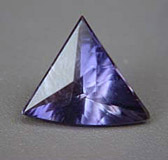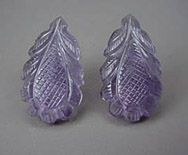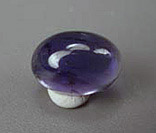

This gem, which represents one of the few relatively available and affordable blue stone options, is rapidly gaining in popularity. Arguably, the gain is due more to exposure in mail order catalogs and on cable shopping channels than to promotion by traditional jewelry stores. Run of the mill stones often have a steely, inky or washed out blue color, but the best specimens can rival AAA Tanzanite in the saturation of their blue-violet hue at some viewing angles.
Iolite is a prime example of a pleochroic gemstone, that is, one whose color depends of the angle of view relative to its crystal axes. As a stone with this property is slowly rotated, a blend of colors appears, then the "true" color for that crytal axis, then another blend, then the other "true" color, etc. The majority of pleochroic stones show two colors, iolite has three. The cutter, then, must orient the rough carefully, taking iolite's trichroism of blue-violet, grey and near colorless into account in order to achieve an attractive "face up" color. Depending on the color of the rough material a stone might be step cut to deepen or enhance color, or windowed and/or shallow cut to lighten the tone.


So far, no treatments have been successfully used to lighten color or to remove inclusions, so one can, at least at this point, assume that iolite gems are untreated. Its hardness of 7-7.5 makes it a suitable jewelry stone, though the presence of cleavage must be taken into account and some care exercised. Most of the iolite in world commerce comes from India, but substantial amounts are also mined in Tanzania, Brazil and Sri Lanka.


Color is foremost in setting value in this gem, as with most colored gemstones. A saturated, medium dark blue-violet is the ideal for the face up color, but it must be accepted that such stones will always lighten and darken, and show greyish tones as they are turned. Cutting cannot be ignored as poorly oriented, cut and polished stones may have muddy, washed out or inky color.
Cabochons are available and reasonably priced. Occasionally, iolite is used as a carving material. Small faceted stones are relatively common and modestly priced. Faceted stones over about 6 carats, that are eyeclean, or better are quite rare and highly valued.